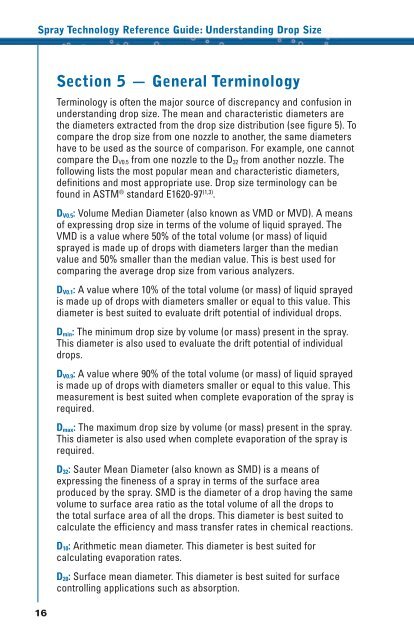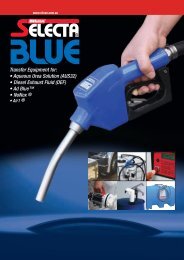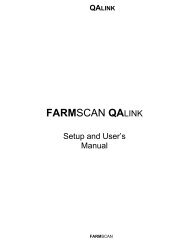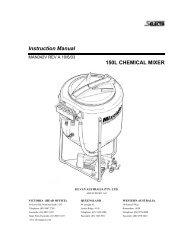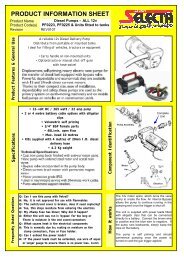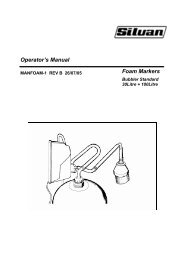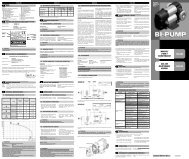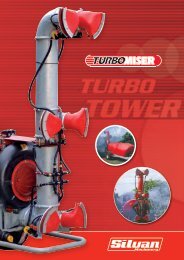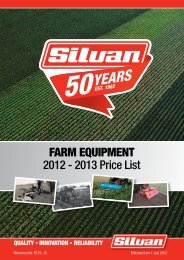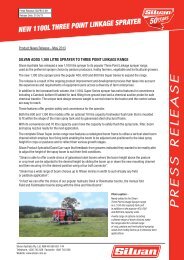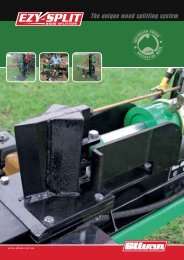Spray Technology Reference Guide: Understanding Drop ... - TeeJet
Spray Technology Reference Guide: Understanding Drop ... - TeeJet
Spray Technology Reference Guide: Understanding Drop ... - TeeJet
You also want an ePaper? Increase the reach of your titles
YUMPU automatically turns print PDFs into web optimized ePapers that Google loves.
<strong>Spray</strong> <strong>Technology</strong> <strong>Reference</strong> <strong>Guide</strong>: <strong>Understanding</strong> <strong>Drop</strong> Size<br />
16<br />
Section 5 — General Terminology<br />
Terminology is often the major source of discrepancy and confusion in<br />
understanding drop size. The mean and characteristic diameters are<br />
the diameters extracted from the drop size distribution (see figure 5). To<br />
compare the drop size from one nozzle to another, the same diameters<br />
have to be used as the source of comparison. For example, one cannot<br />
compare the D V0.5 from one nozzle to the D 32 from another nozzle. The<br />
following lists the most popular mean and characteristic diameters,<br />
definitions and most appropriate use. <strong>Drop</strong> size terminology can be<br />
found in ASTM ® standard E1620-97 (1,3) .<br />
D V0.5 : Volume Median Diameter (also known as VMD or MVD). A means<br />
of expressing drop size in terms of the volume of liquid sprayed. The<br />
VMD is a value where 50% of the total volume (or mass) of liquid<br />
sprayed is made up of drops with diameters larger than the median<br />
value and 50% smaller than the median value. This is best used for<br />
comparing the average drop size from various analyzers.<br />
D V0.1 : A value where 10% of the total volume (or mass) of liquid sprayed<br />
is made up of drops with diameters smaller or equal to this value. This<br />
diameter is best suited to evaluate drift potential of individual drops.<br />
D min : The minimum drop size by volume (or mass) present in the spray.<br />
This diameter is also used to evaluate the drift potential of individual<br />
drops.<br />
D V0.9 : A value where 90% of the total volume (or mass) of liquid sprayed<br />
is made up of drops with diameters smaller or equal to this value. This<br />
measurement is best suited when complete evaporation of the spray is<br />
required.<br />
D max : The maximum drop size by volume (or mass) present in the spray.<br />
This diameter is also used when complete evaporation of the spray is<br />
required.<br />
D 32 : Sauter Mean Diameter (also known as SMD) is a means of<br />
expressing the fineness of a spray in terms of the surface area<br />
produced by the spray. SMD is the diameter of a drop having the same<br />
volume to surface area ratio as the total volume of all the drops to<br />
the total surface area of all the drops. This diameter is best suited to<br />
calculate the efficiency and mass transfer rates in chemical reactions.<br />
D 10 : Arithmetic mean diameter. This diameter is best suited for<br />
calculating evaporation rates.<br />
D 20 : Surface mean diameter. This diameter is best suited for surface<br />
controlling applications such as absorption.


